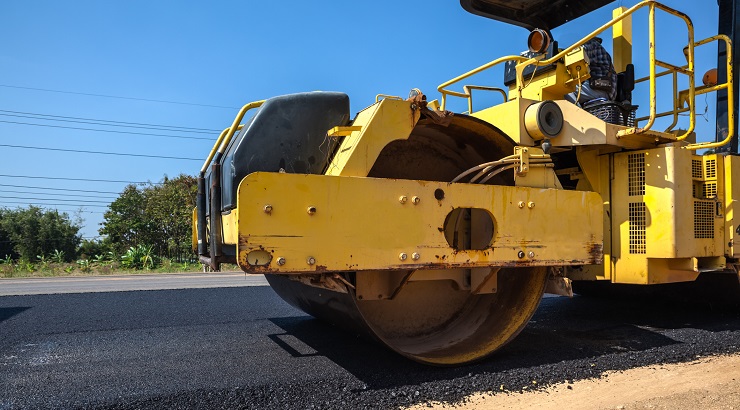Outdoor Living
The ABCs of Asphalt Paving
Everything you need to know about asphalt paving.

Asphalt paving is the laying of aggregate of crushed rock, gravel and sand, bound together with asphalt – a sticky substance obtained from crude oil – to create a pathway that can support vehicular traffic.
It starts with preparation of the subgrade, a process that involves tearing down and hauling away the existing surface; be it concrete, asphalt, pavers, or plants and the topsoil.
The subgrade is graded to allow the water to run off to the sides or bottom. The perfect grade is a quarter of an inch per foot (0.635 cm per 30.48 cm).
Using a 1,361-kg twin drum roller, or an equally powerful roller, the base soil is compacted to reduce its volume of water and air. This helps to create a harder and denser surface that can support traffic loads.
The base soil is then covered with crushed stone, whose structure should be coarse and jagged.
The next step involves laying the crushed rock mixed with bitumen into the subsoil. Once this is done, you should allow the base to settle for a week. This will result in a stronger, more naturally settled base.
RELATED: How to Install Asphalt Driveway in Six Easy Steps
Once the base is ready, hot asphalt is poured onto a bed of heavier aggregate after which it is pressed into it with a steamroller. It cools down to becomes strong enough to support vehicular loads.
Types of Asphalt
Hot Mix Asphalt
Hot Mix Asphalt (HMA), the frequently used asphalt, is a term used to described asphalt mixtures that are heated and poured at high temperatures between 300- and 350-degrees Fahrenheit.
This type of asphalt is commonly used for paving highways and driveways in the United States due to its water resistance and ability to withstand hostile weather conditions.
It is made up of a mixture of 95% rock, sand, or gravel bound together with asphalt – a sticky substance obtained from crude oil. The mixture is heated at a hot mix asphalt plant.
Due to its tendency to cool quickly, HMA is best used when external air temperature is above 40 degrees.
Warm Mix Asphalt
Warm mix asphalt (WMA) is prepared like HMA only that the process is completed at temperatures of between 200- and 250-degrees Fahrenheit.
WMA is cheaper to produce compared with HMA since it uses less fossil fuels. However, more binding material is required to aid pouring and spreading at lower temperatures.
Porous Asphalt
Porous asphalt is an eco-friendly paving material that contains numerous tiny holes to provide a sustainable way of managing stormwater.
The holes allow the water to descend beneath the pavement where it is cleansed naturally. Porous asphalt is excellent for congested cities and areas that experience perennial flooding.
Cold Mix Asphalt
This is the most basic type of asphalt and the easiest to manufacture. As the name suggests, CMA does not require heating for application.
However, it is weaker than hot or warm mix asphalt and should only be used for small-scale solutions such as potholes repair as preparations are made for a permanent fix using HMA.
Benefits of Asphalt Paving
Asphalt is the pavement of choice for most governments and private developers across the world, accounting for 94% of roads in the US.
Here is why asphalt paving is so popular.
1. Asphalt Paving Enhances Safety
Thanks to its water managing abilities, asphalt paving helps with skid resistance during the wet seasons. Besides, the dark color makes it easier for ice to melt thus keeping the pavement safe for users.
2. Economical for Motorists
It is not a secret that asphalt paving produces the smoothest driveways. A smooth road is quite economical for motorists because it cuts fuel usage by enhancing the rolling resistance of tyres.
It also decreases wear and tear on suspensions and shock absorbers particularly on heavy commercial vehicles that are usually fitted with high axle loads.
3. Asphalt Pavement is Durable
A properly installed driveway can last about 15 to 20 years, a duration that can be prolonged with regular preventive maintenance of the pavement.
4. Asphalt Paving Reduces Highway Noise
In many countries, highway noise is regarded as pollution. This can be mitigated by erecting noise reducing barriers along the roads or installing noise protection systems for homes.
The above options are expensive and impractical.
The porous nature of asphalt makes it a cheaper option for highway noise reduction. The open-grade surfaces of asphalt help to absorb noise. Indeed, tests have shown that rubberized asphalt can reduce noise by 50% to 90% – which is very impressive.
5. Asphalt is 100% Recyclable
Nealy 100% of reclaimed asphalt can be used to manufacture new asphalt. In Finland, for example, the percentage of reclaimed asphalt being re-fashioned as new asphalt is 100%.
Recycling of asphalt can help to cut carbon emissions while keeping maintenance costs to a minimum.
Types of Asphalt Paving Damage
Most types of asphalt damage are easily avoidable through preventative maintenance and proper installation.
Should your asphalt show signs of damage it is best to get it repaired right away as smaller problems cost less to fix and can be handled quickly.
Asphalt pavements get damaged with time – the most common types of impairments being cracks, potholes, stripping, depressions, and base failure.
1. Cracks
Cracking mostly occur due to improper paving of a driveway. Common types of cracks include:
– Block Cracks – These are interconnected, rectangular cracks that form when the asphalt binder expands and contracts during temperature variations. This results from laying dry aggregate mix.
– Slippage Cracks – These stretch marks-looking cracks occur because of laying a very weak mix or due to poor bonding between the surface layers.
– Longitudinal Cracks – They run parallel to the centreline of the pavement and are caused by improper erection of the longitudinal joint.
– Alligator Cracks – These are caused by overloading a thin pavement or a problematic subbase layer.
– Edge Cracks – These form near the edge of the pavement due to heavy bushes or lack of support.
– Transverse Cracks – They run vertical to the centreline of the pavement and are caused by problems in the underlying layers of the pavement.
2. Potholes
Potholes mainly appear due to wear and tear from weather and traffic loads on the pavement. These types of damages can be stopped through regular preventative maintenance of the roadway.
3. Depressions
As the name suggests, these are sections of the pavements with lower elevations compared to the rest of the roadway. Depressions usually hold water during the rains causing potholes and cracks.
4. Base Failure
This occurs when the asphalt surface is unable to hold its original shape and caves in. This can be caused by poor drainage, improper installation, or overloading a section of the pavement.
5. Stripping
Stripping is the dislocation of a pavement surface due to weakening of the adhesion between asphalt and the aggregate. Unlike other damages that occur on the surface, stripping happens when lower layers of the pavement fall apart breaking the upper layers.
How to Repair Asphalt Pavement
Crack Filling – This is the process of pouring hot sealant on cracks to fill them up and prevent them from growing bigger. The sealant sticks to the asphalt – stopping water from causing further damage.
Sealcoating – This is the application of a protective coating to old asphalt pavements to protect their surfaces from elements such water, oils, and weather.
It should be applied every 3-5 years, during the warm season.
Milling – This is the removal of the top layer of asphalt without tampering with the subbase. It is ideal for surface repairs for pavements whose subbase is in perfect condition.
Milling is cost effective and can be completed within a very short time.
Patching – This is the process of covering potholes to prevent further damage to concrete.
Overlay – This is similar to patching only that it covers a large damaged section of the pavement.
Asphalt Driveway Cost
The cost of asphalt driveway installation varies from one region to the other mainly due to the size of the driveway, labor costs, asphalt type, as well as the amount of excavation and grading required.
However, the typical range of asphalt driveway cost is $2,932 to $6,568, which translates to $7 to $13 per square foot – including $2 to $6 per square foot for materials and $5 to $7 per square foot for labour.
In the United States, the national average cost of asphalt driveways installation is $4,737.












